As you all know, this project as been a huge endeavor that’s lasted the entire semester. All along Alyssa and I have hoped to make something to represent our message and this is what we’ve come up with.
As you all know, this project as been a huge endeavor that’s lasted the entire semester. All along Alyssa and I have hoped to make something to represent our message and this is what we’ve come up with.
The fact that this semester is almost at an end is sort of mind-boggling and sort of exciting. It means it’s almost time for summer, for the beach, for going home. I’m not sure about all of you, but I can’t wait. I am absolutely ready to be sunbathing, swimming, and taking a bit of a break from classes. At the same time, it’s sad that this year is wrapping up because, like for a lot of you, I won’t be coming back in the fall. And, at least “officially”, this coming Monday will be the last day of the blog. No more free coffee Monday’s…Alyssa and I have started to feel like we’re abandoning the cause. As though those of you who have become interested in the green cause are going to be left wondering, well, now what?
I want to reassure all of you that there are so many other people and organizations on the URI campus who are involved in environmental initiatives that if you really want to be involved, it will be easy to do. The following are just the ones that I’ve become pretty familiar with over the course of this project, but there are many, many more.
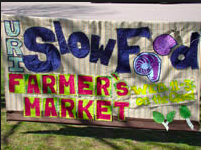 Perhaps the most visible on the URI campus is the Slow Food @ URI movement. Beginning this past Wednesday and lasting through the rest of the semester is a local food market on the URI quad. The market includes various vendors each selling locally grown/made foods and beverages. Great Harvest Bread Co., Bravo Wood-Fired Pizza, The Coffee Guy, Tallulah’s Tacos, are among several that make weekly appearances. But the activities of Slow Food don’t stop there. Currently run by senior Alyssa Neil, Slow Food is active in many ways at URI and they’re incredibly welcoming to new members. To join you can look here, and email the President, Alyssa Neil at the following address: lyssa2225@my.uri.edu or check out their website.
Perhaps the most visible on the URI campus is the Slow Food @ URI movement. Beginning this past Wednesday and lasting through the rest of the semester is a local food market on the URI quad. The market includes various vendors each selling locally grown/made foods and beverages. Great Harvest Bread Co., Bravo Wood-Fired Pizza, The Coffee Guy, Tallulah’s Tacos, are among several that make weekly appearances. But the activities of Slow Food don’t stop there. Currently run by senior Alyssa Neil, Slow Food is active in many ways at URI and they’re incredibly welcoming to new members. To join you can look here, and email the President, Alyssa Neil at the following address: lyssa2225@my.uri.edu or check out their website.
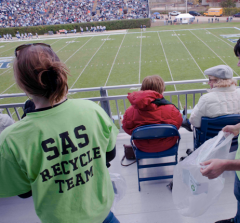
Perhaps less well known than Slow Food is Student Action for Sustainability. A slightly more political group, SAS functions as an advocacy organization for environmental sustainability, as well as a group that leads through example. Often SAS members lead or participate in campus clean ups, environmental campaigns, and other activities. They are located in the Memorial Union Room 304 and meet on Wednesdays from 6:30 to 7:30. You may also contact the group’s President Bianca Peixoto at bpeixoto10@my.uri.edu or check out their website.
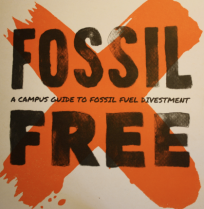 The third and final organization Fossil Free Rhode Island is very, very new, and therefore still very, very small. However, their cause is noble. And while this organization is just arriving at the URI campus, it is hardly the first of it’s kind in the United States or even in Rhode Island. Based out of URI the organization is made up of Sierra Club members, URI faculty, students, and others who have no affiliation to either. The objective of FFRI is essentially divestment of fossil fuels from the URI campus, which would, in turn help local businesses, reduce carbon emissions, and encourage green innovation. You can check out their Facebook page here.
The third and final organization Fossil Free Rhode Island is very, very new, and therefore still very, very small. However, their cause is noble. And while this organization is just arriving at the URI campus, it is hardly the first of it’s kind in the United States or even in Rhode Island. Based out of URI the organization is made up of Sierra Club members, URI faculty, students, and others who have no affiliation to either. The objective of FFRI is essentially divestment of fossil fuels from the URI campus, which would, in turn help local businesses, reduce carbon emissions, and encourage green innovation. You can check out their Facebook page here.
And the last, and coolest thing that I can tell you about URI is that even beyond these organizations you can find people who are interested in their causes. There are courses you can find about environmental sustainability. There are people who make sure to recycle always. There are many motivated people on this campus, but they may not visually label themselves as eco-friendly. I would like to encourage all of you to investigate any or all of these organizations now and in future semesters, and even when no longer a part of the URI community.
One last note that I want to leave you all with is this: Alyssa and I are still here, even if the blog is no longer running officially, we are going to be keeping it up and running when we can. We are completing a project for a class, but we’re also working on this project for ourselves and don’t want to leave it behind—at least not completely. That said, if any of you ever have any questions about environmental issues/sustainability then feel free to contact either of us.
My email address: mary_vidal@my.uri.edu
Alyssa’s: Alyssa_mason@my.uri.edu
Although it’s not apple-picking season, Maggie and I suddenly had a craving for home-made apple pie today. Surprisingly, it was more than 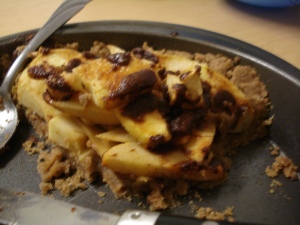 simple to make, and we already had all the required ingredients in our kitchen!
simple to make, and we already had all the required ingredients in our kitchen!
But the best part about this whole cooking experience was that about half of the ingredients we used, aside from certain spices, was either organic or bought from our local farmer’s market.
The Recipe (and yes, we did everything from scratch…and it was well worth it!):
For the crust:
1 1/2 cups of whole wheat flour
2 tsp of sugar
1 tsp of salt
2 tsp soy milk
Directions:
1.) Preheat oven to 400 degrees F (or 200 degrees C)
2.) Mix all ingredients into a 9 inch pan (this will be the pan you bake the crust in)
3.) Pat/flatten the mix to the pan until the surface is even and covers the sides of the pan.
4.) Bake for 13-15 minutes in the oven
4-5 apples
1/3 cup of butter/margarine
1/2 cup sugar
1 tbsp. ground cinnamon
1/4 cup cinnamon sugar
Directions:
1.) Preheat oven to 350 degrees F (or 177 degrees C)
2.) Rinse, peel, and slice apples
3.) Add apple slices into the pan (with crust already made)
4.) Dot apple slices with half of the butter/ margarine; mix the remaining margarine with sugar and ground cinnamon
5.) Sprinkle mixture over apples
6.) Sprinkle cinnamon sugar over apples and mixture
7.) Bake for 40-45 minutes
Total cook time: 1 hour
End result: Deliciousness
But why am I writing about baking pie… of all things?
For one, to show that we practice what we “preach,” and to provide a specific example of how easy it is to cook sustainably/ create delicious food with organic and “health-nut” products.
As mentioned above, about half of our ingredients either came from a local farmer’s market or were bought at our local Stop and Shop, strictly from the organic aisle.
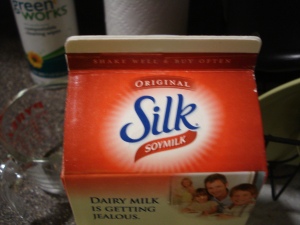
For starters, the apples came from the Hope Artist Village Farmer’s Market in Pawtucket (my hometown), and the butter and soy milk was bought at Stop and Shop, but from organic providers, such as Silk (which is a part of the NON GMO Project) and Kate’s Homemade Butter (the cows are not treated with GMOs).
Note: “GMO” means genetically modified organism. Why are they bad? Watch:
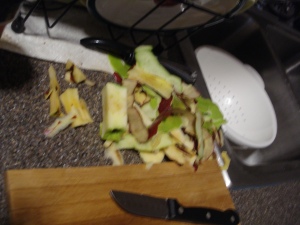 bin.
bin. 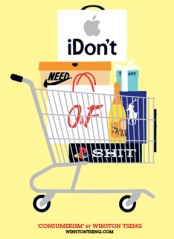 Today, I want to think about a question that’s been plaguing me throughout this project. This question is something that I’ve always wanted to write about, but never followed through with. I think it’s because I have no answer to the question. So I’ve decided I’m not going to try to answer it. Instead I want to bring issues to light, challenge assumptions, spur self-reflection, and perhaps incur a bit of a debate. So here’s my question. What do we need to live happy and healthy lives?
Today, I want to think about a question that’s been plaguing me throughout this project. This question is something that I’ve always wanted to write about, but never followed through with. I think it’s because I have no answer to the question. So I’ve decided I’m not going to try to answer it. Instead I want to bring issues to light, challenge assumptions, spur self-reflection, and perhaps incur a bit of a debate. So here’s my question. What do we need to live happy and healthy lives?
I’ve brought this idea up before in passing, suggesting that yes, it’s good to try to be eco-friendly, but not at the expense of our own happiness. In my way of thinking, what’s the point then? If we want a better environment so that we all will be able to lead long, happy lives, wouldn’t it be counterproductive to make ourselves miserable in our attempts? Colin Beavan, in his memoir style novel No Impact Man, attempts to unpack this question of how to rectify these two desires: one, to protect the planet, and two, to be sanguine, to be more than simply contented with our lives.
own happiness. In my way of thinking, what’s the point then? If we want a better environment so that we all will be able to lead long, happy lives, wouldn’t it be counterproductive to make ourselves miserable in our attempts? Colin Beavan, in his memoir style novel No Impact Man, attempts to unpack this question of how to rectify these two desires: one, to protect the planet, and two, to be sanguine, to be more than simply contented with our lives.
What he suggests is that we are not dependent on many of the things that we think we are. Beavan believes that we are subject to our consumer society. That we have been trained to think that we need convenience and we need things.
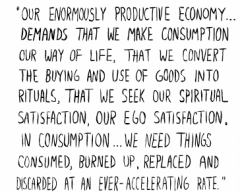 I think he may have a point. Having grown up a part of a typical middle-class American family, I am used to having anything I really want at my fingertips. Shirts, shoes, tooth paste, shampoo, Kit-Kats, toilet paper, pens, pencils, paper, granola bars, laptops, mp3 players, makeup, Poptarts, glasses, contacts, necklaces, apples, bracelets, cellphones, cups, bread, plates, bowls, microwaves, water bottles, refrigerators, toasters, coffeemakers, ibuprofen, Band-Aids, Styrofoam cups, plastic utensils, televisions, movies, CDs…it goes on and on and on.
I think he may have a point. Having grown up a part of a typical middle-class American family, I am used to having anything I really want at my fingertips. Shirts, shoes, tooth paste, shampoo, Kit-Kats, toilet paper, pens, pencils, paper, granola bars, laptops, mp3 players, makeup, Poptarts, glasses, contacts, necklaces, apples, bracelets, cellphones, cups, bread, plates, bowls, microwaves, water bottles, refrigerators, toasters, coffeemakers, ibuprofen, Band-Aids, Styrofoam cups, plastic utensils, televisions, movies, CDs…it goes on and on and on.
Until reading Beavan’s book, I’ve never really questioned my right to consume. If I could 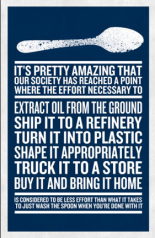 afford it, why not? Why would I choose to give up something I wanted? Beavan suggests two reasons: first, many of these things cause negative environmental impact (plastic packaging, using fossil fuels to produce them, using a lot of electricity etcetera) and second, if I thought about it hard enough, or stopped using some of these products, I’d realize that they don’t make me any happier than I would be without them. Sometimes, they may even inhibit our happiness by limiting our contact with people we love.
afford it, why not? Why would I choose to give up something I wanted? Beavan suggests two reasons: first, many of these things cause negative environmental impact (plastic packaging, using fossil fuels to produce them, using a lot of electricity etcetera) and second, if I thought about it hard enough, or stopped using some of these products, I’d realize that they don’t make me any happier than I would be without them. Sometimes, they may even inhibit our happiness by limiting our contact with people we love.
If we divide some of the purchases we make into two categories, basic needs, meaning items we need to survive, and discretionary needs, meaning items we would like to have, we can look at consumer spending a little more clearly. For example, in the U.S. 70% of the economy is based on purchases of discretionary needs items. While many families cannot afford these kinds of purchases, for many families they make up a significant percentage of their incomes.
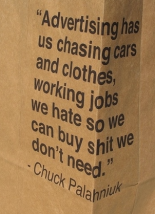
This is problematic in several senses. First, in order to afford these purchases, families must commit enormous amounts of time to working (the average American works over 40 hours a week), taking away time they would spent with their loved ones. Second, when Americans get their paychecks, they spend large portions of it on home entertainment, like movies and television and videogames, so even when they’re home with their families, they’re not actually spending time in each other’s company. And third, because Americans work so many hours (at a job they might not even like) that when they’re finally free of their duties, they don’t want to take advantage of the purchases they’ve made. It’s an endless, happiness-seeking cycle.
Annie Leonard, the creator of the Story of Stuff, explains it best in this short video:
Colin Beavan’s book details how he and his family try to avoid this cycle, and how they do so successfully. The Beavan’s decide they will only purchase second-hand items, aside from clothes, and that they will only buy non-prepackaged food items (avoiding creating extra trash for convenience—something they realized also doesn’t make them happy).
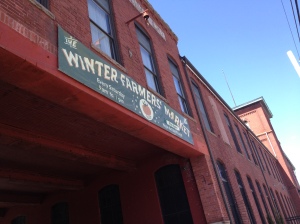 In my own life I’ve begun noticing that Beavan has some good points. He argues that environmental action is beneficial to the self—that it makes us enjoy our lives and our company more than we could otherwise. And in the some of the (subtle) ways I’ve started employing his logic in my life, I’ve begun to agree. See, I’ve started cooking a lot at home, and eating out less, and it’s fun because I can cook with my friends. I’ve stopped going clothes shopping frequently, and started seeing my wardrobe in new ways (and saving myself some cash). And Alyssa and I have started going to local food markets, where we explore different food items and vendors that we’ve never heard of or tried before. We’ve made friends with the man who sells his homemade goat cheese in Providence, we’ve chatted with the ladies who make their own applesauce and cider, we’ve met bakers and farmers. And while, yes, it was a bit more expensive, we didn’t have to use plastic bags, or plastic wrap, or other single-use food packaging, and we spent the afternoon having fun while food shopping, rather than feeling harried and rushed in Stop and Shop.
In my own life I’ve begun noticing that Beavan has some good points. He argues that environmental action is beneficial to the self—that it makes us enjoy our lives and our company more than we could otherwise. And in the some of the (subtle) ways I’ve started employing his logic in my life, I’ve begun to agree. See, I’ve started cooking a lot at home, and eating out less, and it’s fun because I can cook with my friends. I’ve stopped going clothes shopping frequently, and started seeing my wardrobe in new ways (and saving myself some cash). And Alyssa and I have started going to local food markets, where we explore different food items and vendors that we’ve never heard of or tried before. We’ve made friends with the man who sells his homemade goat cheese in Providence, we’ve chatted with the ladies who make their own applesauce and cider, we’ve met bakers and farmers. And while, yes, it was a bit more expensive, we didn’t have to use plastic bags, or plastic wrap, or other single-use food packaging, and we spent the afternoon having fun while food shopping, rather than feeling harried and rushed in Stop and Shop.
Like I’ve said, I’m not suggesting that I have the answers. I’m not sure that this is the “best” way. But what I know is that so far, I’m happier than I was before and I’ve started creating a smaller environmental impact. Should you do it too? That’s for you to decide. Is it worth it for me? Definitely. So what am I saying? Just think about it.
Climate change is the biggest fallacy of all time. Who knew, right?
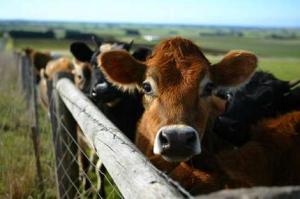 This is quite embarrassing for Maggie and me to admit, especially after our countless months of ranting about “going green” and creating less waste… But our aim for this blog is to give you the full truth, even if it goes against our prior beliefs.
This is quite embarrassing for Maggie and me to admit, especially after our countless months of ranting about “going green” and creating less waste… But our aim for this blog is to give you the full truth, even if it goes against our prior beliefs.
So, following the words of researcher, writer and lead 350 organizer, Bill McKibben, we are giving you the full truth about climate change: the main cause for climate change is an increase in animals’ flatulence.
Despite all the literature, documentaries, and news articles, climate change is mainly caused by animals expelling flatus…multiple times a day, every day.
I mean, it makes sense. Have you ever passed by a farm? The smell is unmistakable… it is the smell of animals passing gas–it is the smell of green house gases (GHGs) accruing and heating up our atmosphere.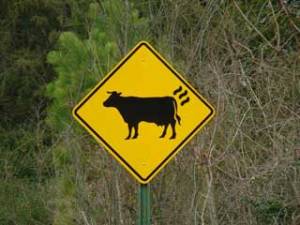
It’s not because we burn 260, 000 gallons of gasoline every passing minute for our motor vehicles alone,
or because we throw away 9,960 pieces of junk mail every three seconds.
It’s definitely not because we discard 400,000 water bottles every minute
or because we waste 320,000 light bulbs, equal to the number of kilowatt hours used every minute from inefficient usage (i.e. spotty wiring, leaving appliances plugged in/ on when not in use, etc.).
It’s actually really relieving to know that the 106,000 aluminum cans we Americans toss every 30 seconds, or the 1 million plastic cups distributed on US airline flights every 6 hours, or the 426,000 cell phones we discard every day, or even the 1.14 million brown paper supermarket bags we use each hour and the 60,000 plastic bags we use every 5 seconds is not the cause of climate change.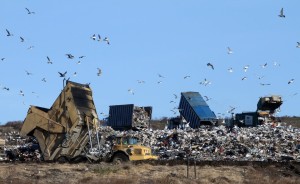
Especially being a student, who has her fair share of papers to write, and of course inevitably print, it’s a huge relief to know that the 15 million sheets of office paper we use every 5 minutes does not attribute to climate change.
What a relief.
Flatulence… who knew???
And to find it out on the first of April… how convenient.
Happy April Fool’s Day!
*Note: For obvious reasons, the information in this post is misconstrued. That said, all statistics provided come from actual resources. To read the sources firsthand, you can go HERE and HERE.
To learn more about 350.org, you can go HERE.
*** ALSO: Animal flatulence IS indeed part of the accumulation of GHGs in our atmosphere, except instead of referring to it as flatulence, experts refer to it as “methane gas.”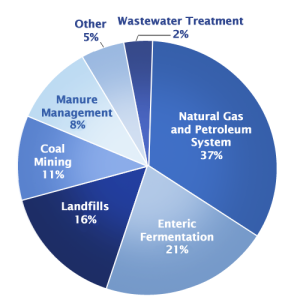
Domestic livestock such as cattle, buffalo, sheep, goats, and camels produce large amounts of CH4 [ a.k.a. methane gas] as part of their normal digestive process. Also, when animals’ manure is stored or managed in lagoons or holding tanks, CH4 is produced. Because humans raise these animals for food, the emissions are considered human-related (EPA).
So to make a long story short: Farts are a part of livestock’s digestive systems (as it is for humans). However, because humans raise livestock for agricultural purposes, these emission are attributed to human behavior, (i.e. the real main cause for climate change).
According to the EPA, the Agriculture sector is the primary source of CH4 emissions. So yes, animal flatulence cause climate change, but only because we humans have created an economy 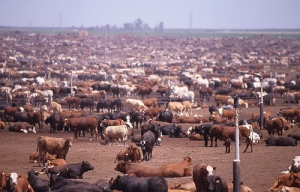 dependent on agriculture, or rather “factory farming.” To give you an idea of how big factory farming is, the United Nations claims that livestock now take up 30 per cent of the earth’s entire land surface. That’s a lot of cattle…which means a lot of methane gas.
dependent on agriculture, or rather “factory farming.” To give you an idea of how big factory farming is, the United Nations claims that livestock now take up 30 per cent of the earth’s entire land surface. That’s a lot of cattle…which means a lot of methane gas.
Moral of the story: Fart jokes are the epitome of April Fool’s pranksters…but in this instance, it’s a killer.
– Alyssa
Sometimes, when I say something about the environment I know to be truth, I’m faced with confusion or out-right disagreement. The most obvious of which—Global Warming isn’t the fault of humans—also being the most ridiculous. For those people who Alyssa and I haven’t yet convinced that global warming is, in fact, real and, in fact, the fault of humans I’m not sure what else to say, other than look at this website. Maybe they’ll have better luck.
For everyone else, there are still some environmental misconceptions, especially in relationship to our health.
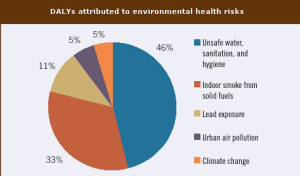
In 2013 all Earth life is faced with greater levels of toxicity than ever seen during the era of humans. Both unfortunately and ironically this happens to be the fault of humans too. The toxicity that I’m talking about manifests in a ton of different forms, in our air, soil, water, food… And all of those things may have a different effect on our health.
I wrote a blog post a couple months ago about pollution from landfills and several health problems, especially asthma. More recently I wrote a post about how cigarette butts can pose huge hazards to human and animal life. And just the other day I posted about the health effects of Styrofoam cups. Perhaps for some of you these things were already clear, but until having done the research I was completely unsure of what was true and what was not. And I think this is completely understandable because there’s a ton of literature out there on it—some reliable, some not so reliable—and most it is confusing or contradictory.
For instance, when I was reading about Styrofoam I learned that many people consider them more environmentally friendly, simply because they measure being “good” for the environment in a different way than I would. If you don’t want to take my word for it read more here.
The following is a chart of three of the various ways that toxicity in our environments affects our health.
While all of these types of pollution/environmental abuse are potentially health threatening, I want to focus on consumer products because it seems to be both the only factor we can exert personal control over.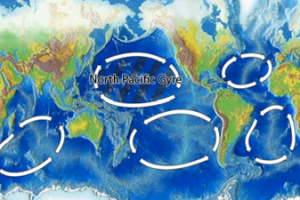
In 5 major areas of the globe’s oceans there are enormous gyres of plastics that are called Garbage Patches. Our ocean’s currents converge in these areas, bringing along with them hundreds and thousands of pounds of plastics, where they, over the course of years, break down into smaller and 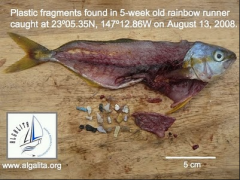 smaller pieces of plastic. Because these plastics breakdown into miniscule pieces birds and marine life often believe them to be food—plankton—and these animals ingest the plastic. Through the various levels of the food chain fish end up full of these plastics and the toxins that they leach. Often these fish end up on our tables—end up being our food—and, in turn, release toxins into our bodies.
smaller pieces of plastic. Because these plastics breakdown into miniscule pieces birds and marine life often believe them to be food—plankton—and these animals ingest the plastic. Through the various levels of the food chain fish end up full of these plastics and the toxins that they leach. Often these fish end up on our tables—end up being our food—and, in turn, release toxins into our bodies.
All of this seems a little unbelievable, but the details are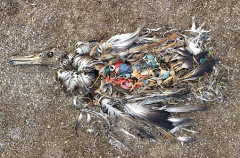 even more astonishing. Not only are at least 100,000 marine animals killed yearly via starvation (the plastics don’t digest in their bodies, so the animals feel full and stop eating), but the plastics that are filling up our oceans are estimated to weigh more than 100 million tons, creating the potential for vast numbers of other animals to be ingesting great amounts of plastic—but instead of starving to death, these fish are harvested and sold in our supermarkets. How appetizing.
even more astonishing. Not only are at least 100,000 marine animals killed yearly via starvation (the plastics don’t digest in their bodies, so the animals feel full and stop eating), but the plastics that are filling up our oceans are estimated to weigh more than 100 million tons, creating the potential for vast numbers of other animals to be ingesting great amounts of plastic—but instead of starving to death, these fish are harvested and sold in our supermarkets. How appetizing.
On land, plastics do a significant amount of damage in other ways. The buzzword here, ladies and gentlemen, is Bisphenol A (aka BPA). This chemical can be found in water bottles, baby bottles, plastic toys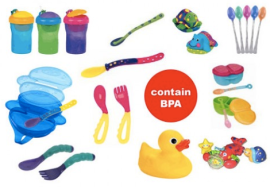 , lining the insides of metal containers, and in various other places. BPA has been linked with a wide array of serious health issues including heart disease, breast cancer, diabetes, attention deficit disorder, ovarian disease, and low sperm counts. Studies show that most any plastics (even those without BPA) have other toxins, such as Polyethylene Terephthalate (PET), that leach toxins that act like estrogen into beverages and foods.
, lining the insides of metal containers, and in various other places. BPA has been linked with a wide array of serious health issues including heart disease, breast cancer, diabetes, attention deficit disorder, ovarian disease, and low sperm counts. Studies show that most any plastics (even those without BPA) have other toxins, such as Polyethylene Terephthalate (PET), that leach toxins that act like estrogen into beverages and foods.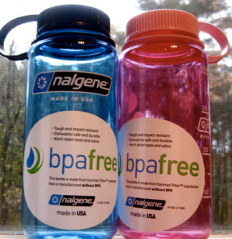
Basically, despite the wide array of research boils down to is this: synthetic products can have severely negative effects on both the environment and our health. To best protect ourselves from such dangers—environmental and otherwise—I suggest swapping out plastic products for reusable metal, glass, or even paper products. Get coffee at Bagelz? Use a travel mug! Drink from plastic water bottles? Use a metallic one! Or a plastic one that’s BPA free. Afraid of tap water? Buy a Britta filter and filter you own water!
In essence? Avoiding the problem is easy—so long as we’re aware it’s there.
-M
For some time now, Maggie and I have talked, semi-exclusively about all the green things we need to start doing to save the world. Sure, we intersperse the terms “the URI co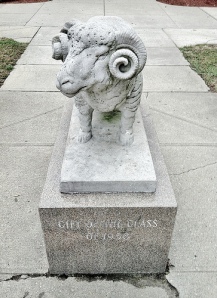 mmunity” in between research data to make it relevant to our little Rhody… but I’m sure a good handful of you have wondered: is this really relevant?
mmunity” in between research data to make it relevant to our little Rhody… but I’m sure a good handful of you have wondered: is this really relevant?
The answer is yes, but that is because everything we discuss is relevant to EVERYBODY (global warming= global community). That said, there are things that our URI campus does that make the green movement, sustainability, and all other things that fall under the realm of “eco-activism” pertinent to our Kingston community.
For starters, did you know we have a sustainability plan and sustainability programs?
In fact, we have three!
The Climate Action Plan, the Greenhouse Gas Inventory, and the Strategic Plan for Campus Sustainability.
But what do they do? Or more importantly, what does that mean for us, the students?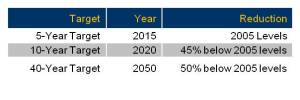
Without getting into the nitty-gritty of every proposal, it means that our University is aware, and has been aware since 2007 (go them), about the world’s growing issues with climate change and global warming. In order to make a difference, the University has created organizations/ programs, like the President’s Council for Sustainability and the Energy Fellows, to keep tabs on the University’s waste and green house gas emissions. In response to the data, URI plans to lower the green house gas (GHG) emission rates by implementing new sustainable practices (i.e. reducing the amount of energy and water we use per capita) as well as installing new equipment (like solar panels and energy-saving machines) campus wide. Hillside Anyone?
To the left is an overview chart that includes the sources of all of URI’s Kingston and Bay campus emissions, agricultural emissions, and the URI ocean research vessel Endeavor 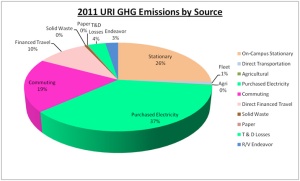 from 2011.
from 2011.
The following data shows that since the implementation of CAP, the emissions of GHGs has slowly-but surely- has begun to decrease:
Scope one refers to the emissions controlled by URI, such as heating and cooling systems, as well as the agricultural sources used on Peckham Farm.
Electricity usage is considered “scope two” and represents purchased electricity, purchased steam water, and purchased chilled water. The University of Rhode Island only purchases electricity from an outside source.
Scope three refers to the indirect sources that the University cannot directly control such commuting to campus by the students, faculty, and staff, directly financed travel by car or airplane, transmission and distribution losses from the production of purchased electricity, paper used, and solid waste to landfill.
And to top it all off, URI has focused on the following five areas to promote more sustainable practices throughout the URI campus to achieve the following goals:
1. Increase environmental literacy among all undergraduate students
So, what’s the take- away for today?
URI is working towards a greener and more sustainable future. Our officials are working towards change.
BUT, that doesn’t mean as students we stop because “the guys in suits” support green initiatives and proposals. “Most conservation projects described in the CAP require the help of the entire campus community to make them successful” (URI).
URI has overcome one of the biggest struggles when it comes to implementing big change: getting the officials to listen. Now that we have their attention, it is time to make the changes we all need.
Our campus has a plethora of information about being green at URI and plenty of resources to help our community live a greener lifestyle. So what are we waiting for? Go Green.
To learn about the specific goals behind URI’s CAP you can go here.
To look at the specifics behind URI’s Green House Gas Inventory you can go here.
To look at the specifics behind URI’s Strategic Plan for Sustainability you can go here.
–Alyssa
When Alyssa, M., and I went down to Washington D.C. for the #ForwardOnClimate Rally, we anticipated meeting people who supported all sorts of environmental causes—people against fracking, people against industrial farming, people for green technology—but what we hadn’t anticipated was how we’d run into these people.
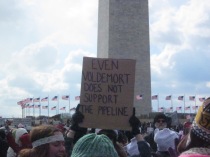 When we piled off the bus, we were immediately engulfed in crowds of hundreds of people, and soon enough we were separated from the rest of the Rhode Island Sierra Club . Realizing that trying to find them again would be fruitless, we adventurously decided to go off on own. We squeezed our way through clumps of people with posters saying anything from the straightforward “I ❤ Clean Air” and “Forward On Climate” to witty quips like “Even Voldemort Doesn’t Support the Pipeline” and “Frack You”, but got stuck when we reached a parade of people with white and red hats, chanting: What do we want? Polar bears! What do they need? Ice! And somehow—still not clear on how this happened—we ended up in the front of their parade, chanting along with them, caps (that we can now see are the faces of polar bears) on our own heads.
When we piled off the bus, we were immediately engulfed in crowds of hundreds of people, and soon enough we were separated from the rest of the Rhode Island Sierra Club . Realizing that trying to find them again would be fruitless, we adventurously decided to go off on own. We squeezed our way through clumps of people with posters saying anything from the straightforward “I ❤ Clean Air” and “Forward On Climate” to witty quips like “Even Voldemort Doesn’t Support the Pipeline” and “Frack You”, but got stuck when we reached a parade of people with white and red hats, chanting: What do we want? Polar bears! What do they need? Ice! And somehow—still not clear on how this happened—we ended up in the front of their parade, chanting along with them, caps (that we can now see are the faces of polar bears) on our own heads.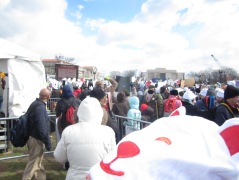
When this parade reached the main event we broke off from our new friends. Disappointingly, however, they never explained to us their specific mission. We were left only with the clues that our hats gave us: Chill the Drill embroidered on the back.
Since then I’ve being doing some research and now, I think I understand.
The National Oceanic and Atmospheric Administration (NOAA) released its annual Arctic Report Card for 2012 a few months ago and the claims the organization makes are sobering. According to this report card the climate in the arctic over the last decade demonstrates a definite shift into a new “environmental state” based on “record low snow”, record “duration of melting”, “nearly ice-sheet wide melting”, “severe weather”, and “increased growing seasons”. Basically, it’s getting warmer. I’m simplifying for the sake of clarity, but this simplification of facts doesn’t make the message here any less serious.
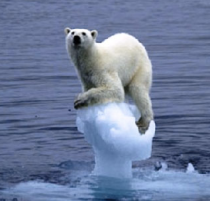 If this new state is for-good it could hold dramatic changes and problems for the marine and terrestrial life of the arctic, as well as climate changes that would affect the rest of the globe. For instance, if the ice continues to melt, sea levels will rise drastically and ocean-side locations (like our very own little ocean state) will face flooding that could overwhelm our normal coastlines. Coastal cities and towns (can you say Narragansett?) would be ravaged by increased sea levels.
If this new state is for-good it could hold dramatic changes and problems for the marine and terrestrial life of the arctic, as well as climate changes that would affect the rest of the globe. For instance, if the ice continues to melt, sea levels will rise drastically and ocean-side locations (like our very own little ocean state) will face flooding that could overwhelm our normal coastlines. Coastal cities and towns (can you say Narragansett?) would be ravaged by increased sea levels.
Having read all this I was still curious about the embroidered message on the hat. What was the reference to “drills”? What I found is not so surprising—perhaps I should’ve known. According to the Sierra Club, gas and oil companies are, despite the advice of experts, trying to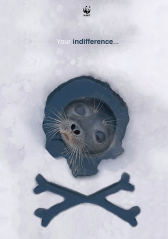 drill in precious arctic areas that host thousands of kinds of wildlife and tundra. As we’ve seen examples of in the past, drilling for gas and oil often leads to monumental problems, like oil spills, that kill thousands of animals, damage their environment, and essentially ruin entire ecosystems. Yay. And plus, drilling for oil in such a fragile area speaks to the completely ridiculous idea that fossil fuels and the industry that needs them are more important than
drill in precious arctic areas that host thousands of kinds of wildlife and tundra. As we’ve seen examples of in the past, drilling for gas and oil often leads to monumental problems, like oil spills, that kill thousands of animals, damage their environment, and essentially ruin entire ecosystems. Yay. And plus, drilling for oil in such a fragile area speaks to the completely ridiculous idea that fossil fuels and the industry that needs them are more important than 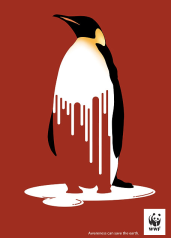 sustaining life on Earth. The more efforts that we put towards finding and harvesting fossil fuels the farther away we get from finding alternative sources of power (like the solar/wind/water powers Alyssa’s told you about).
sustaining life on Earth. The more efforts that we put towards finding and harvesting fossil fuels the farther away we get from finding alternative sources of power (like the solar/wind/water powers Alyssa’s told you about).
But, here’s something thrilling. We can do something about it. Below I’ve given you contact information for Rhode Island Senators Jack Reed and Sheldon Whitehouse, as well as our representatives James Langevin and David Cicilline. Contacting one of our representatives and letting them know that you care, letting them know what you think, is the first, and most important step to making a difference.
Representative David Cicilline
After all, as Margaret Mead said, Never doubt that a small group of thoughtful, committed citizens can change the world; indeed, it’s the only thing that ever has.”
So, for those of you lovely tree-huggers/ blog supporters/ (hi Mom!)/ eco-aware bloggers who have been regularly following us and our pursuit for a greener 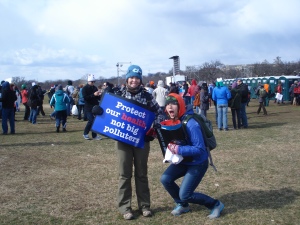 and more environmentally aware URI campus–you know that Maggie, our friend M., and I went to Washington D.C. back in February to the Forward On Climate Change Rally.
and more environmentally aware URI campus–you know that Maggie, our friend M., and I went to Washington D.C. back in February to the Forward On Climate Change Rally.
For those of you who have zero clue about what I am mentioning, you should watch the following video:
In short, we went to Washington to show our President and the nation that climate change is a serious issue, and we wanted action–starting with the rejection of the Keystone Pipeline.
You might ask: “But why?” And again, I ask you to watch:
To make a long story short, the use of tar sands to procure oil is probably the worst idea that America could take on–the potential, and very likely, health risks are insurmountable.
But we’re not the only college students who are protesting for change; check out 350.org.
350 is a grassroots movement that puts divestment at the forefront of their major goal for creating a cleaner, safer, and healthier earth. Their name “350” is 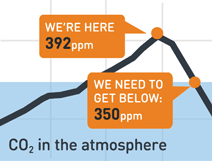 to represent what many scientists, climate experts, and progressive national governments are now saying is the safe upper limit for CO2 in our atmosphere–currently we are at 390. The group spans worldwide, reaching over 188 countries! And they are committed to making their message spread even farther. But I want to pause on their mission statement and focus on a word you might not be familiar with: DIVESTMENT. It’s something we all can do.
to represent what many scientists, climate experts, and progressive national governments are now saying is the safe upper limit for CO2 in our atmosphere–currently we are at 390. The group spans worldwide, reaching over 188 countries! And they are committed to making their message spread even farther. But I want to pause on their mission statement and focus on a word you might not be familiar with: DIVESTMENT. It’s something we all can do.
But what is it?
As most of you may know, America and other parts of the world, depend largely on fossil fuels (a.k.a. why we are having serious issues with global warming and climate change). Divestment, is the social, political, educational and humanitarian act (yes, all of these things) to say no to the use of fossil fuels… Sounding familiar yet?
350 is one of the main groups supporting the rejection of the Keystone Pipeline. This pipeline and others like it are the type of expenditures 350 opposes. Their mantra “It’s wrong to profit from wrecking the climate” is the guiding words that ask national, state-wide, and local institutions to “divest from fossil fuels“
So what exactly does that mean?
It means refusing to support corporations that create fossil fuels; it means choosing not to fund investments for fossil fuel companies; and most importantly, it means supporting the creation of and funding for green energy (i.e. wind, solar and hydro).
In simpler terms:
When you invest your money, you might buy stocks, bonds or other investments that generate income for you. Universities and Colleges, like religious institutions and pension funds, put billions of dollars in these same kinds of investments to generate income to help run their institutions.
Divestment is the opposite of an investment–it simply means getting rid of stocks, bonds or investment funds that are unethical or morally ambiguous. Fossil Fuel investments are a risk for investors and the planet–that’s why we’re calling on institutions to divest from these companies. —350.org
And the best part, is that divestment is something that can be done as an individual or as a part of a large institution:
So what’s my point?
Although it was nice to take a short walk down memory lane with you, this post is not meant to repeat what has already been said in February, but to remind you that the decision to confirm or deny the construction of the Keystone Pipeline is still up for debate! Our work as tree-huggers and eco-activists is not over.
In fact, there now exists an electronic campaign that allows you to pledge your name to support the rejection of the Keystone Pipeline. If you want to add your name to the petition, you can go here to join others in telling Mr. President Obama that the Keystone Pipeline is NOT the solution to America’s struggling economy.
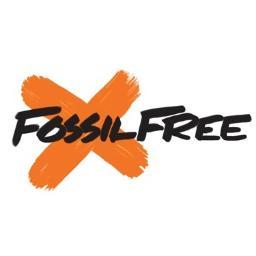
Also: If you want a more active role in DIVESTMENT, without being a part of an organization, you can go here to learn how to make sure your money funds clean energy versus coal and oil companies.
OR: If you are a part of a group already and what to see what you can do together, you can go here.
***
Even though I have enjoyed my time writing this blog and researching about all the good and the bad that our nation (and other countries) have to offer, I realize that my blogging is just one small spec of the difference-making I can achieve for our little Rhody– I write to inform, to motivate, and yes, to sometimes persuade everyone into action. But even after I research and write the same matter still stands, and we all have to face it.
The heat is rising. So what are we gonna do about it?
-Alyssa
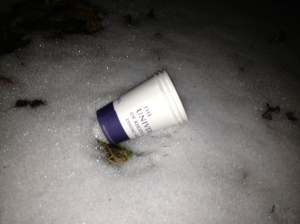 As most of you are probably aware, in addition to this blog Alyssa and I have created a Free Coffee Monday at Bagelz in the Emporium for customers who use travel mugs. The idea is based off using an incentive—free coffee— to encourage travel mug use, with the hope that the use of a travel mug will soon become a habit among Bagelz customers. Look here for some cool options!
As most of you are probably aware, in addition to this blog Alyssa and I have created a Free Coffee Monday at Bagelz in the Emporium for customers who use travel mugs. The idea is based off using an incentive—free coffee— to encourage travel mug use, with the hope that the use of a travel mug will soon become a habit among Bagelz customers. Look here for some cool options!
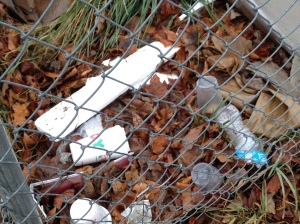 We came up with this idea last semester when the two of us began noticing single-use bottles and cups strewn about the campus, in the hands of many of our peers and faculty, and in trash cans everywhere.
We came up with this idea last semester when the two of us began noticing single-use bottles and cups strewn about the campus, in the hands of many of our peers and faculty, and in trash cans everywhere.
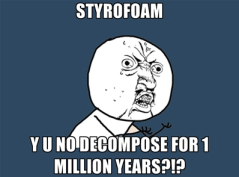
I think everyone knows that there are a lot of single-use products used on the URI campus, but we estimated that at Bagelz alone about 500 polystyrene (aka Styrofoam) cups are used everyday, and all of those end up either on campus grounds or in the Johnston landfill. Like the cigarette butts I mentioned in my last post, Styrofoam is not biodegradable. The difference is that, unlike the cigarette butts, Styrofoam is also resistant to other forms of decay—from water and light—so every single one of those cups lasts forever.
Very recently I received an email suggesting that Alyssa and I look into convincing Bagelz to stop using Styrofoam cups to serve their hot beverages. The reasoning? It’s awful for the environment. This person is correct.
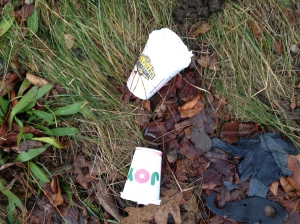 Some argue that Styrofoam cups are, in fact, more eco-friendly than paper cups. And perhaps this side of the argument is not all wrong; paper cups do have their own failings. They take more energy/water to create, don’t retain heat/cold as well as Styrofoam, they require a cardboard sleeve to protect the holder’s hands, and because paper cups are typically lined with plastic on the inside they can take up to 20 years to biodegrade. And, probably the most influential factor? Paper cups cost more.
Some argue that Styrofoam cups are, in fact, more eco-friendly than paper cups. And perhaps this side of the argument is not all wrong; paper cups do have their own failings. They take more energy/water to create, don’t retain heat/cold as well as Styrofoam, they require a cardboard sleeve to protect the holder’s hands, and because paper cups are typically lined with plastic on the inside they can take up to 20 years to biodegrade. And, probably the most influential factor? Paper cups cost more.
What this sid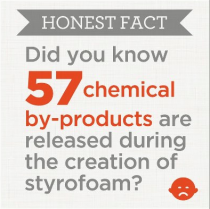 e of the argument forgets is that Styrofoam is made from petroleum—a non-sustainable resource—the production of which creates huge amounts of air pollution. Plus, during the actual making of the Styrofoam 57 other chemicals are released as by-products. More importantly this argument seems to ignore that Styrofoam can have serious health side effects—especially when used with hot beverages.
e of the argument forgets is that Styrofoam is made from petroleum—a non-sustainable resource—the production of which creates huge amounts of air pollution. Plus, during the actual making of the Styrofoam 57 other chemicals are released as by-products. More importantly this argument seems to ignore that Styrofoam can have serious health side effects—especially when used with hot beverages.
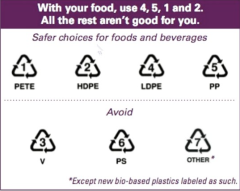 Styrene—the main building block of polystyrene or Styrofoam—can cause a slew of health problems from messing with our hormone levels leading to problems with the thyroid, menstrual cycles, and breast and prostate cancers, to problems with the make up of our blood, to issues with our nervous systems. Basically the seemingly innocent and perfectly safe action of drinking coffee (unless you burn your mouth) is twisted into a dangerous, potentially life-threatening action when is done using a Styrofoam cup.
Styrene—the main building block of polystyrene or Styrofoam—can cause a slew of health problems from messing with our hormone levels leading to problems with the thyroid, menstrual cycles, and breast and prostate cancers, to problems with the make up of our blood, to issues with our nervous systems. Basically the seemingly innocent and perfectly safe action of drinking coffee (unless you burn your mouth) is twisted into a dangerous, potentially life-threatening action when is done using a Styrofoam cup.
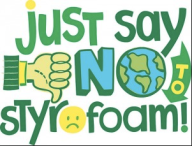
The paper cup, on the other hand, is hardly as ominous.